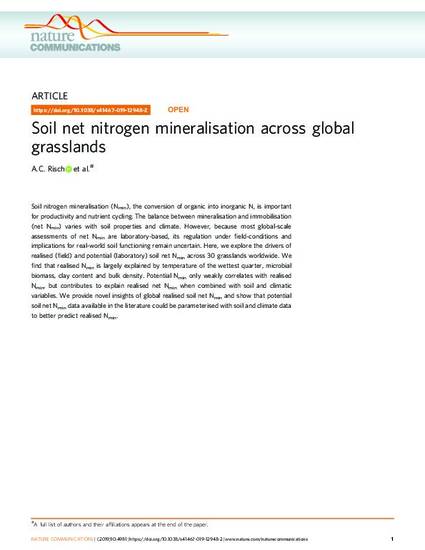
Soil nitrogen mineralisation (Nmin), the conversion of organic into inorganic N, is important for productivity and nutrient cycling. The balance between mineralisation and immobilisation (net Nmin) varies with soil properties and climate. However, because most global-scale assessments of net Nmin are laboratory-based, its regulation under field-conditions and implications for real-world soil functioning remain uncertain. Here, we explore the drivers of realised (field) and potential (laboratory) soil net Nmin across 30 grasslands worldwide. We find that realised Nmin is largely explained by temperature of the wettest quarter, microbial biomass, clay content and bulk density. Potential Nmin only weakly correlates with realised Nmin, but contributes to explain realised net Nmin when combined with soil and climatic variables. We provide novel insights of global realised soil net Nmin and show that potential soil net Nmin data available in the literature could be parameterised with soil and climate data to better predict realised Nmin.
This work was conducted within the Nutrient Network (http://www.nutnet.org) experiment, funded at the site-scale by individual researchers. The soil net Nmin add-on study was funded by two internal competitive WSL grants to A.C.R., B.M., M.Sc., F.H. and S.Z. as well as to B.F., A.C.R. and S.Z. Coordination and data management have been supported by funding from the National Science Foundation Research Coordination Network (NSF-DEB-1042132) to E.T.B. and E.W.S., and from the Long-Term Ecological Research (LTER) programme (NSF-DEB-1234162), and the Institute on the Environment at the University of Minnesota (DG-0001-13).
The data will be available at www.envidat.ch. https://doi.org/10.16904/envidat.87.
Source data for Figs. 2, 4, 5, Supplementary Figs. 1–8 can be found in the source data file.
Available at: http://works.bepress.com/rebecca_mcculley/65/

Published in Nature Communications, v. 10, article no. 4981.
© The Author(s) 2019
This article is licensed under a Creative Commons Attribution 4.0 International License, which permits use, sharing, adaptation, distribution and reproduction in any medium or format, as long as you give appropriate credit to the original author(s) and the source, provide a link to the Creative Commons license, and indicate if changes were made. The images or other third party material in this article are included in the article’s Creative Commons license, unless indicated otherwise in a credit line to the material. If material is not included in the article’s Creative Commons license and your intended use is not permitted by statutory regulation or exceeds the permitted use, you will need to obtain permission directly from the copyright holder. To view a copy of this license, visit http://creativecommons.org/ licenses/by/4.0/.
The first 20 authors (including the one from the University of Kentucky) are shown on the author list above. Please refer to the downloaded document for the complete author list.